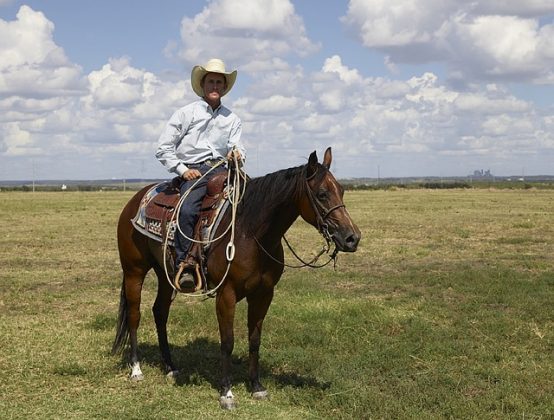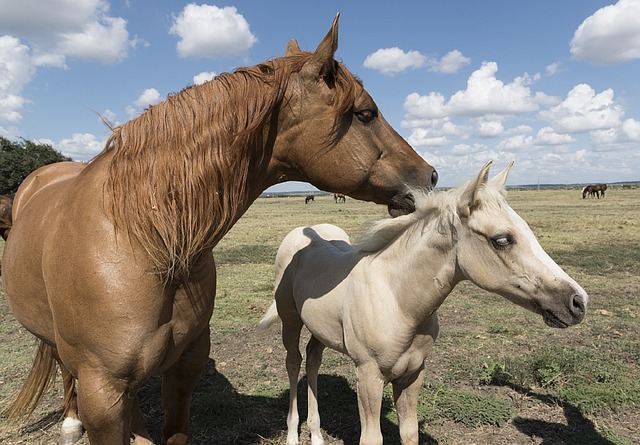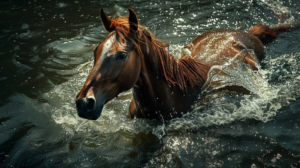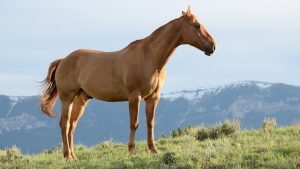The American Quarter Horse is the most popular breed of horse in the world, and with good reason. The Quarter Horse is strong, sure-footed, and even-tempered. It is a superb animal athlete and can stop and turn in an instant or run at breakneck speed for a quarter mile. Quarter Horses are prized for their natural talent in working cattle and for their gentle disposition as family pleasure horses.
They are also valued highly for their speed on the racetrack, with one of the highest stakes in horse racing—$1,000,000—going every Labor Day to the winner of the famous All American Futurity at Ruidoso Downs, New Mexico. While the American Quarter Horse has been around for a long time, it did not become an official breed until 1940, when its own association was founded for keeping records on the breeding and accomplishments of these versatile horses.
Brown Quarter Horse MareSince then, more than two million animals have been officially registered as American Quarter Horses. This number does not include horses that are mostly of Quarter Horse ancestry or those whose owners did not take the trouble and go to the expense of having their animals officially registered.
Quarter Horses are popular in countries other than the United States, especially ones like Australia, where large herds of cattle are raised. The American Quarter Horse is clearly a product of the United States, one whose history is closely tied to the settlement and expansion of this country. Like so many American accomplishments, this special breed is the result of the mixture of influences from different countries that went into the making of America.
Even before the establishment of the Virginia Colony by the English, horses were important on this continent to the Spanish and the Indians. By 1671, there were already close to 10,000 horses in Virginia, and among these were the first Quarter Horses, already known and respected for their speed.
Competition has always been a part of human society, and many people have found horse racing one of the most exciting and satisfying kinds of competition. In the colonies, a new type of race was developed that suited the limitations of colonial life and the talents of colonial horses.
A short race covering only a quarter of a mile, run straight along a road such as the main street of a town, became the standard contest for judging a horse’s speed. Roads were few and poorly built, and the colonists could not spend the time and money necessary to build special tracks at which races could be held.
The quarter-mile stretch was a practical length. Besides, quick bursts of speed were more important in horses used for practical purposes such as herding cattle than was the ability to keep up speed over long distances. The goal of those developing the Quarter Horse has always been the same—to produce a reliable working animal that could put on rapid bursts of speed.

The result is a solidly built but not tall horse, with strong, muscular legs, shoulders, and rump. The Quarter Horse carries its head low, which helps it keep its balance and footing on the rough terrain where it so often has to work. Quarter Horses are heavier for their height than any other breed of saddle horse, an indication of how much hard-working muscle their bodies carry.
Descriptions of the early colonial horses sound very much like that of the modern Quarter Horse. When the Quarter Horse was officially established in 1940, Robert Denhardt and Helen Michaelis made a thorough study of breed origins and came to the conclusion that the traits of the Quarter Horse were already recognizable by about 1665.
Where Do They Live?
Quarter Horses live in many different places. Some are backyard horses, with only a small pasture to roam in. Others are pampered show horses that spend most of their time in warm stalls. But since the Quarter Horse typically lives on a western ranch, we will take a look at the life of working Quarter Horses.
New-born and infant horses, called foals, are born in the springtime. While racehorses are often born early in the year, working horses are generally born later when the weather has warmed up and the grass is growing. That way, the rancher does not have to worry about cold weather endangering his foals, and the mother horses (mares) will have plenty to eat.
The mares and foals are left to romp, play, and graze in the pasture on their The American Quarter Horse as it exists today was perfected as a cow horse. No other breed possesses the special combination of traits—sure-footedness, strength, agility, and calm temperament—that make the Quarter Horse ideally suited to ranch work.
It can dash fast enough from a standing start to run down a wayward cow, and it is strong and heavy enough to pull against the weight of a roped calf struggling to escape. It knows how to work with cattle and can perform many ranch skills with little or no guidance from its rider.
A cowboy can ride his Quarter Horse hard while rounding up cattle for branding and then leave it saddled and tied to a fence rail for hours waiting to be ridden again. For these reasons, Quarter Horses are by far the most popular horses used on cattle ranches today A good cow horse is invaluable.
It has “cow sense,” the instinct to work with cattle and the knowledge of how to control them. When ranchers are working cattle—moving a herd or roping calves for branding—things often happen too fast for the rider to give commands to his or her mount. The horse must often make its own decisions about how to keep the cattle in line. For example, if it sees a steer bolt from the herd, it needs to dash right after the steer, moving to the outside and turning it back into the herd.
A cow horse is a partner with its rider. When a calf is roped, the horse must pull back on the rope to tighten the loop around the calf, and it must keep the rope taut, even after the rider has jumped off to work on the roped animal. Cattle have to be moved for many reasons. If the rancher owns several pastures, the cattle may need to be moved now and then from one pasture to another to ensure that they do not overgraze one area, damaging the grass so that it cannot grow back quickly.
In the late spring or early summer, a herd must be brought to branding corrals so that the calves can be branded. And in the fall, when the cattle are big enough to sell for beef, they are moved to a railroad or to a feedlot. While some ranchers nowadays use motorcycles to herd their cattle, most still prefer horses, which are far quieter and cause much less stress to the cattle.
Quarter Horse racing is now very popular, and many animals are especially bred for use in races. “Cutting,” a competition featuring the Quarter Horse’s ability to work with cattle, is also growing rapidly. Cutting Quarter Horses come from different breeding than racehorses. Quarter Horses are also featured in their own horse shows, with competitions for the best-looking horses and the best-trained ones under saddle. After many years of breeding in search of horses that can win at these different competitions, the American Quarter Horse today is almost several different breeds under one name.





